Wenn Sie neu in Stickereien sind, Das Verständnis von Maschinenstickerei -Grundlagen kann sich ein bisschen überwältigend anfühlen. Aber keine Sorge - wir sind hier, um es Schritt für Schritt aufzubrechen! In diesem Ratgeber, Wir werden Sie durch alles führen, was Sie wissen müssen, um loszulegen, Von der Auswahl der richtigen Maschine und der richtigen Materialien bis zum Lernen grundlegender Stiche und Techniken.
Maschinenstickerei eröffnet endlose kreative Möglichkeiten, Erlaubt Ihnen, Kleidung zu personalisieren, Geschenke, und Wohnkultur mit eigenen Designs. Durch das Erlernen dieser Grundlagen, Sie werden in der Lage sein, einfache Stoffe in Schöne zu verwandeln, Benutzerdefinierte Stücke. So, Lassen Sie uns eintauchen und das Nötigste erkunden, Helfen Sie, das Vertrauen und die Fähigkeiten aufzubauen, die Sie benötigen, um atemberaubende Stickprojekte zu erstellen.
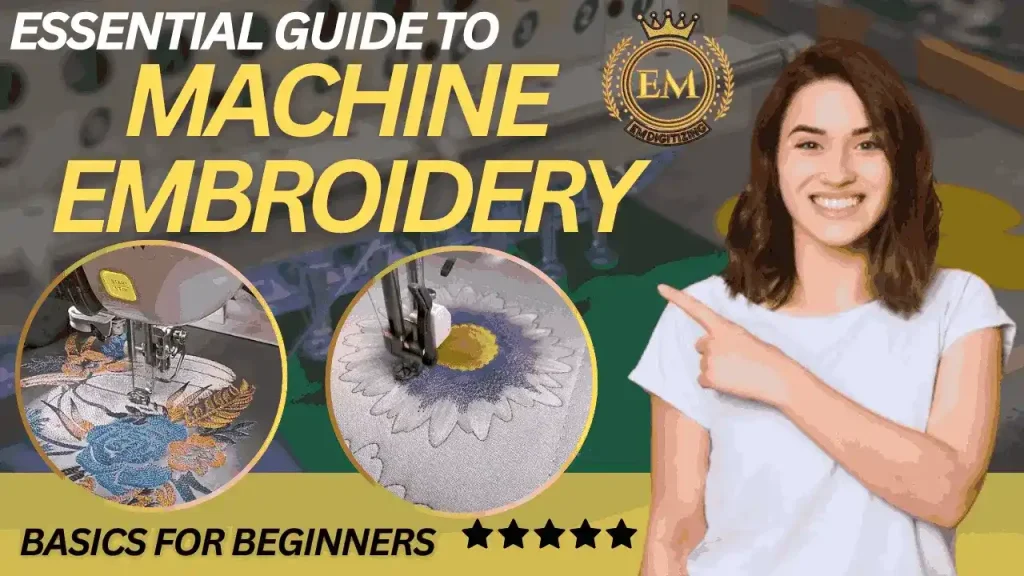
Grundlegender Leitfaden zu den Grundlagen der Maschinenstickerei für Anfänger
Grundmaterialien, die für die Maschinenstickerei benötigt werden
Um die Grundlagen der Maschinenstickerei zu verstehen, Es ist wichtig, über die grundlegenden Materialien und Werkzeuge zu erfahren, einschließlich Software, Das macht den Prozess reibungslos und erfolgreich. Hier sind die Schlüsselelemente, die Sie benötigen:
- Stickmaschine
- Stickrahmen
- Stickgarne
- Sticksoftware
- Stabilisatoren
- Sticknadeln
- Stoff
- Schere
Jetzt, da Sie die wichtigsten Grundlagen der Stickerei verstehen, Tauchen wir im Detail tiefer in jede Komponente ein.
1. Stickmaschine
Eine Stickmaschine ist ein spezielles Gerät, das komplizierte Muster und Konstruktionen auf Stoff nähert. Im Gegensatz zu Standardnähmaschinen, Stickmaschinen verwenden digitale Dateien und automatisierte Nähte, um präzise zu produzieren, konsistente Ergebnisse. Sie sind sowohl für Hobbyisten als auch für Fachkräfte, die Maschinenstickereien lernen und erstellen möchten, unerlässlich Personalisierte oder benutzerdefinierte Designs.
Arten von Stickmaschinen
Es gibt ihn in verschiedenen Ausführungen, jeweils so konzipiert, dass sie unterschiedliche Bedürfnisse erfüllen, Von einfachen Heimprojekten bis hin zu kommerziellen Nutzung mit hohem Volumen. Hier ist ein ausführlicher Blick auf die Haupttypen von Stickmaschinen:
1. Stickmaschinen mit Single-Nadel
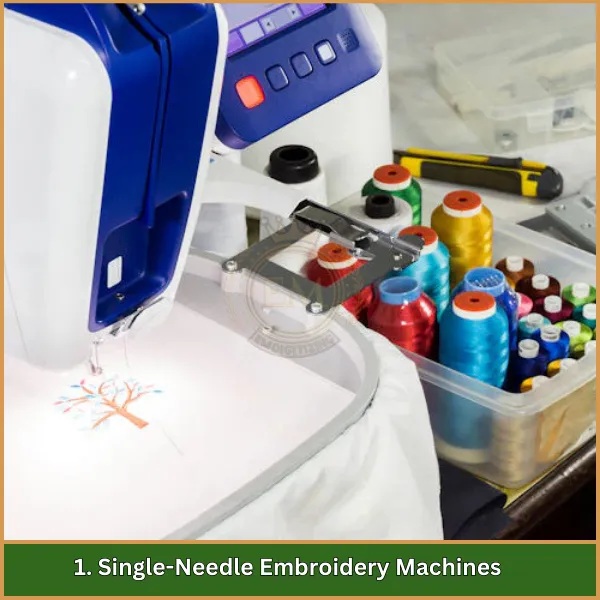
Stickmaschinen mit Single-Nadel-Maschinen sind der häufigste Typ für den Heimgebrauch. Sie haben eine Nadel, Dies bedeutet. Erstellen Sie mehrfarbige Designs, Sie müssen den Thread für jede Farbe manuell ändern.
Merkmale:
- Benutzerfreundlichkeit: Maschinen mit Single-Nadel sind benutzerfreundlich und unkompliziert, sie ideal für Anfänger machen.
- Kompakte Größe: Diese Maschinen sind normalerweise kleiner und tragbarer, Perfekt für Heim -Setups.
- Vielseitigkeit: Einige Modelle mit Einzelnötigen können auch als Nähmaschinen fungieren, Mehrwert für Benutzer, die sowohl für das Nähen als auch für Stickereien interessiert sind.
Am besten für: Hobbyisten, Anfänger, und diejenigen, die gelegentlich Stickprojekte durchführen.
2. Mehrnadel-Stickmaschinen
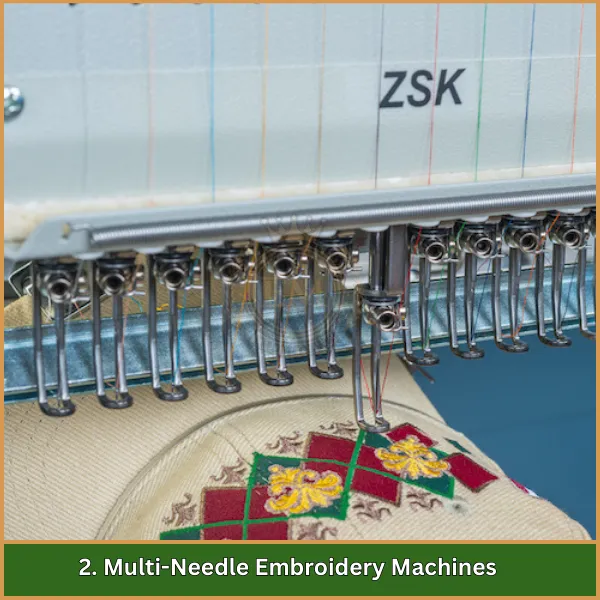
Mehrnadel-Stickmaschinen sind für die Effizienz ausgelegt und werden häufig von Fachleuten verwendet. Diese Maschinen haben mehrere Nadeln (Typischerweise 4 zu 10), Ermöglichen.
Merkmale:
- Geschwindigkeit und Effizienz: Multi-Bedienmaschinen sparen Zeit, indem sie die Farben automatisch ändern, sie für komplexe Designs viel schneller machen.
- Höhere Stickfeldgröße: Viele Multi-Bedienmaschinen bieten größere Stickfelder an, Ideal für größere oder detailliertere Designs.
- Erweiterte Funktionen: Sie sind oft mit fortgeschrittenen Funktionen wie automatischem Thread -Trimmen geliefert, Fadenbrucherkennung, und anpassbare Sticheinstellungen.
Am besten für: Profis, Kleinunternehmer, oder jemand, der mit hohem Volumen oder komplexen Stickprojekten umgeht.
Wichtige Funktionen bei der Auswahl einer Stickmaschine zu berücksichtigen
Bei der Auswahl einer grundlegenden Stickmaschine für Anfänger, Einige wichtige Funktionen können einen großen Unterschied in Ihrer Stickerfahrung bewirken. Hier sind die wichtigsten Dinge, nach denen man suchen muss:
- Eingebaute Designs und Schriftarten: Viele Maschinen sind mit vorbelasteten Designs und Schriftarten ausgestattet, erleichtert das sofort Projekt.
- Stickfeldgröße: Dies ist der maximale Bereich, den Sie in einem einzigen Reifen sticken können. Größere Felder ermöglichen größere Designs.
- Nähgeschwindigkeit: Schnellere Stichgeschwindigkeiten sparen Zeit, insbesondere für große Projekte oder detaillierte Designs.
- Designtransferoptionen: Überprüfen Sie, ob die Maschine USB unterstützt, W-lan, oder direkte Computerverbindungen für einfache Designtransfers.
- Automatisches Fadenabschneiden: Diese Funktion schneidet den Faden zwischen Stichen, Halten Sie Ihre Arbeit ordentlich und sparen Sie Zeit.
- Farb-Touchscreen: Ein Farb -Touchscreen kann Ihnen die Vorschau und Bearbeitung von Designs mühelos vor dem Nähen unterstützen und bearbeiten.
Jedes dieser Funktionen kann Ihr Stickerlebnis verbessern, Es ist also hilfreich, basierend auf Ihren Projektanforderungen und -präferenzen auszuwählen.
2. Stickrahmen
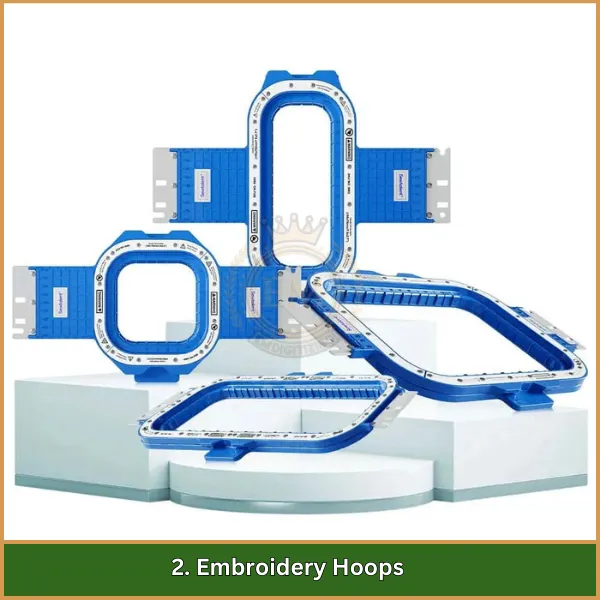
Sie sind wesentliche Werkzeuge in der Maschinenstickerei, Wird verwendet, um den Stoff fest zu halten. Sie sorgen für Stabilität, Verschiebung reduzieren, und helfen dabei, die Präzision jedes Stichs aufrechtzuerhalten, Das ist entscheidend für saubere und professionelle Ergebnisse. Hier ist ein detaillierter Blick auf Stickropps und ihre Bedeutung.
Arten von Stickelmen
- Standardreife: Dies sind grundlegende Reifen, die mit den meisten Stickmaschinen ausgestattet sind. Sie werden in der Regel für kleinere Projekte oder einfache Designs verwendet und eignen sich perfekt für Anfänger.
- Magnetreifen: Magnetische Reifen verwenden Magnete, um den Stoff an Ort und Stelle zu halten. Sie sind ideal für empfindliche Stoffe, die durch traditionelle Klemmreferen beschädigt werden könnten, wie Seide oder dünne Baumwolle.
- Jumbo- oder Multi-Positionen-Reifen: Diese Reifen sind größer und ermöglichen es, größere oder mehrteilige Designs ohne Wiederholung genäht zu werden. Sie sind besonders nützlich für große Projekte wie Decken, Jacken, oder Steppdecken.
- Verstellbare Reifen: Einige Reifen ermöglichen Größenanpassungen, Das macht sie für verschiedene Stickprojekte vielseitig vielseitig. Sie sind bequem, wenn Sie zwischen Designs unterschiedlicher Größe wechseln.
3. Stickgarne
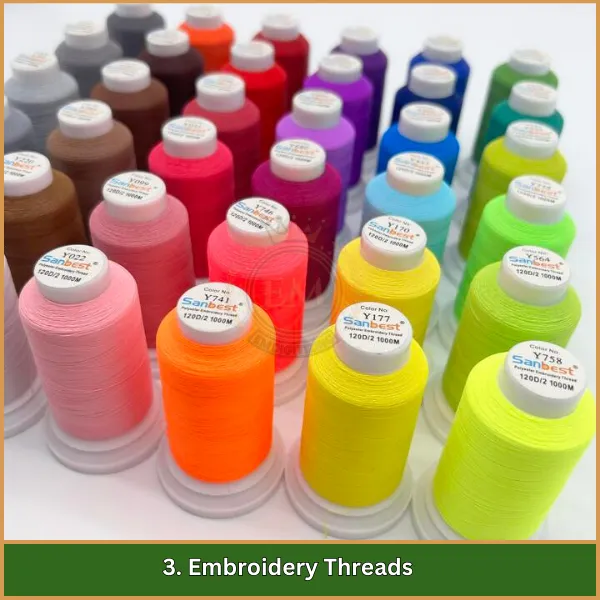
Sie sind eine Schlüsselkomponente in der Maschinenstickerei, Designs mit lebendigen Farben zum Leben erwecken, Texturen, und endet. Die Qualität und Art des Fadens, den Sie wählen, kann das Aussehen stark beeinflussen, Haltbarkeit, und Gesamterfolg Ihres Stickprojekts. Erforschen wir im Detail Stickelthreads, um ihre Rolle zu verstehen, Typen, und Tipps für die Verwendung.
Arten von Stickwäsche
Das Verständnis der verschiedenen Arten von Stickfäden ist für die Mastering -Maschine Stickereien unerlässlich. Jeder Typ bietet einzigartige Eigenschaften, die das Aussehen und die Haltbarkeit Ihrer Designs beeinflussen können.
- Rayonfaden: Bekannt für seine lebendigen Farben und Glanz, Ideal für dekorative Designs mit einem glatten Finish.
- Polyesterfaden: Langlebig und fade-resistent, Perfekt für Gegenstände, die häufig gewaschen werden, Wie Uniformen und Sportbekleidung.
- Baumwollfaden: Hat ein mattes Finish, einen natürlichen Look bieten, und eignet sich hervorragend für Vintage- oder weichere Designs.
- Metallic -Faden: Fügt Funkeln und Textur hinzu, Ideal für dekorative Projekte, Es erfordert jedoch eine sorgfältige Handhabung aufgrund seiner empfindlichen Natur.
- Seidenfaden: Luxuriös und glatt, Wird für High-End- oder empfindliche Stickprojekte verwendet; Es fügt eine Geldstrafe hinzu, elegantes Finish.
- VERSCHAFTER Thread: Ändert die Farbe entlang des Strangs, Erstellen eines einzigartigen Gradienteneffekts, der einfachen Designs Interesse erhöht.
Jeder Threadtyp hat spezifische Verwendungen, allowing you to choose based on your project’;s Bedürfnisse und gewünschte Effekte.
Gewichte und Dicke
Stickfäden kommen in unterschiedlichen Gewichten, Normalerweise reicht von 30 zu 60. Niedrigere Zahlen zeigen dickere Fäden an, Während höhere Zahlen feinere Threads darstellen. Das richtige Gewicht zu wählen ist wichtig:
- 40-Gewichtsfaden ist die häufigste und funktioniert gut für die allgemeine Stickerei.
- 60-Gewichtsfaden ist feiner und geeignet für detaillierte Designs oder kleine Beschriftungen.
- 30-Gewichtsfaden ist dicker, Ideal für mutige Designs, die hervorstechen müssen.
4. Sticksoftware
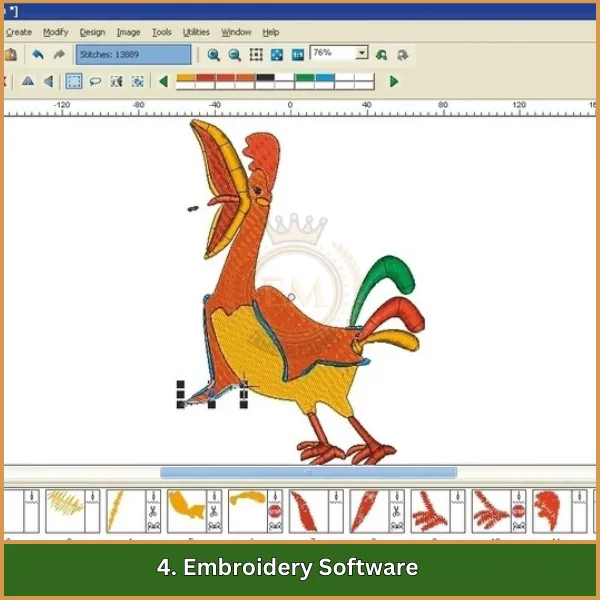
Es ist ein wichtiges Werkzeug zum Erstellen, Bearbeitung, und Konstruktion von Designs in Maschinenstickerei. Dadurch können Benutzer Muster anpassen, Stichtypen einstellen, und sogar Bilder in stickfreundliche Formate umwandeln. Mit der richtigen Software, Sowohl Anfänger als auch Profis können ihre kreativen Ideen leicht zum Leben erwecken.
Zweck der Sticksoftware
Sticksoftware dient mehreren Funktionen, Von der grundlegenden Designerstellung bis zur fortschrittlichen Bearbeitung. Es ermöglicht den Benutzern:
- Erstellen Sie Originaldesigns: Zeichnen oder importieren Sie Formen und Muster zum Erstellen einzigartige Stickmotive.
- Bestehende Muster bearbeiten: Ändern Sie vorhandene Entwürfe durch Größenänderung, rotierend, oder die Farben zu den Projektanforderungen ändern.
- Dateien konvertieren: Standardbilddateien transformieren (wie JPEG oder PNG) In Stickedateiformate (wie Sommerzeit, PES, oder exp) dass Maschinen lesen können.
- Vorschau -Designs: Sehen Sie sich an, wie das Design aussehen wird, wenn sie genäht werden, Ermöglichen Sie Anpassungen, bevor Sie den Stickprozess beginnen.
Wichtige Funktionen, auf die Sie bei Sticksoftware achten sollten
- Benutzerfreundliches Bedienfeld: Eine einfache Schnittstelle ist hilfreich, besonders für Anfänger, Da das Erlernen der Software schneller und einfacher das Lernen.
- Entwurfsanpassungsoptionen: Suchen Sie nach Funktionen wie Text hinzufügen, Größenänderung, Farbanpassungen, und Schichten, um jedes Design anzupassen.
- Dateikompatibilität: Stellen Sie sicher, dass die Software die Dateiformate unterstützt, die Ihre Stickmaschine liest, wie Sommerzeit, PES, oder JEF.
- Vorschau und Simulation: Ermöglicht eine Vorschau, wie das Design auf Stoff aussieht, Hilfe bei der Ermittlung potenzieller Probleme vor dem Nähen.
- Stichbearbeitung: Einige Software ermöglicht eine erweiterte Bearbeitung von Stichtypen, Dichte, und Richtung, Das ist vorteilhaft für komplexere Designs.
5. Stabilisatoren
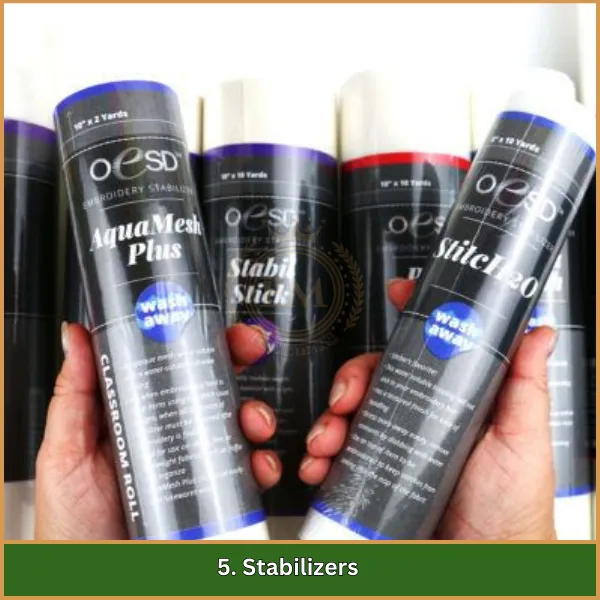
Sie sind wesentliche Materialien, die in Maschinenstickereien verwendet werden, um Stütze zu unterstützen und das Strecken zu verhindern. Sie helfen dabei, die Form des Stoffes aufrechtzuerhalten, Falten verhindern, und stellen Sie sicher, dass Stiche sauber und gut definiert bleiben. Die Auswahl des richtigen Stabilisators ist entscheidend, um qualitativ hochwertige Stickergebnisse zu erzielen, Besonders bei herausfordernden Stoffen.
Arten von Stabilisatoren
- Schnittstabilisatoren: Diese bieten eine dauerhafte Unterstützung und bleiben nach dem Nähen am Stoff befestigt. Sie eignen sich am besten für dehnbare oder empfindliche Stoffe, die dauerhafte Stabilität erfordern.
- Abreißstabilisatoren: Entwickelt für vorübergehende Unterstützung, Sie reißen nach dem Nähen leicht ab. Ideal für stabile Stoffe wie Baumwolle und Denim, für die keine langfristige Unterstützung erforderlich ist.
- Wasserlösliche Stabilisatoren: Löst sich vollständig in Wasser auf, hinterlässt keine Spuren. Perfekt für Spitzendesigns oder schiere Stoffe, bei denen Sie keinen sichtbaren Stabilisator wünschen.
Wärmeableitende Stabilisatoren: Entfernen durch Wärme, Sie ideal für Stoffe, die nicht gewaschen oder zerrissen werden können. Diese Stabilisatoren funktionieren gut mit empfindlichen oder Spezialmaterialien.
6. Sticknadeln
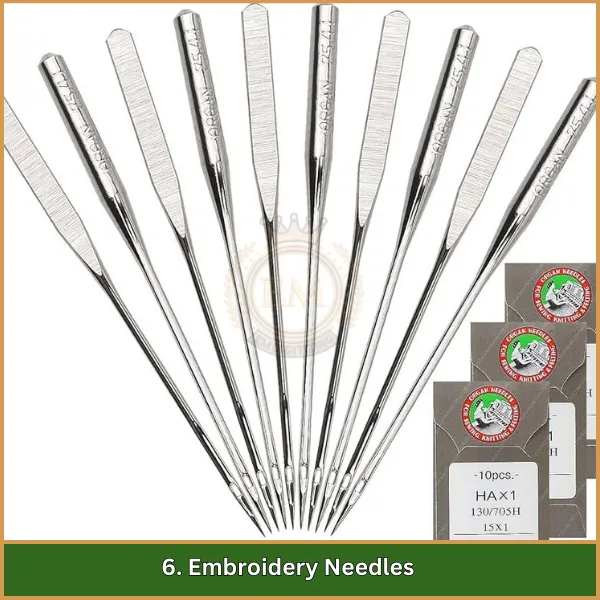
Sie sind speziell mit größeren Augen und einem glatten gestaltet, Abgerundete Spitze, um Stickfäden zu behandeln, ohne Anfragen oder Haken zu verursachen. Die Auswahl der richtigen Nadelgröße und -art ist für die Reinigung von entscheidender Bedeutung, Sogar Stiche an verschiedenen Stofftypen.
7. Stoff
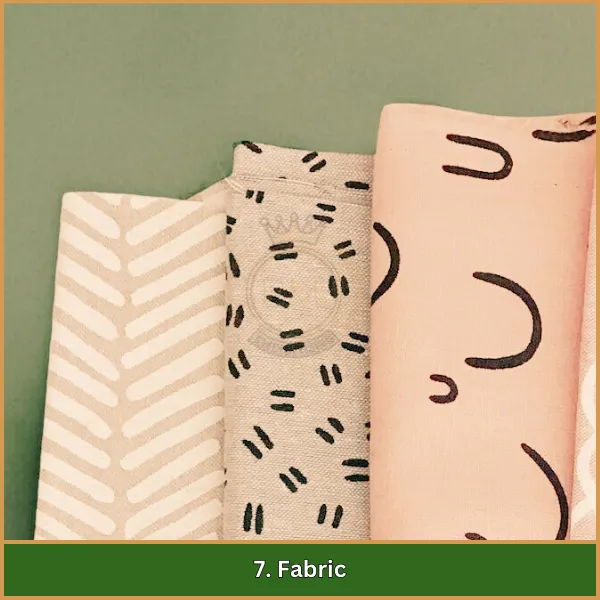
Es ist die Basis für jedes Stickprojekt, und die Auswahl des Rechten kann das Endergebnis stark beeinflussen. Unterschiedliche Stoffe interagieren eindeutig mit Fäden und Stabilisatoren, Die Auswahl des entsprechenden Stofftyps ist daher wichtig für ein reibungsloses und professionelles Finish.
8. Schere
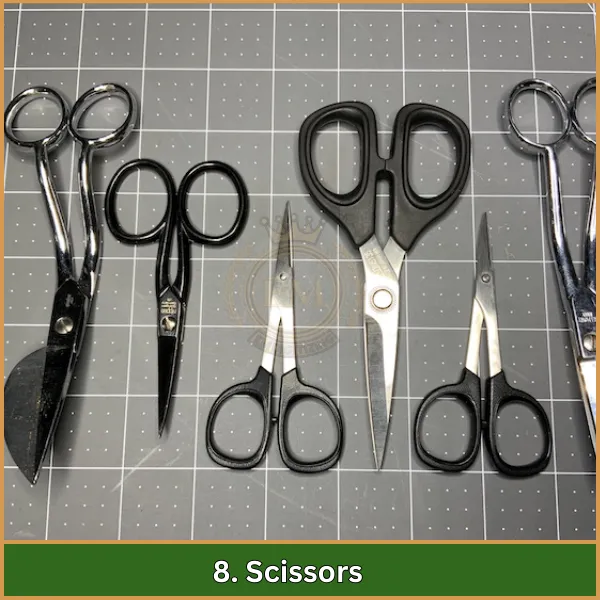
Sie sind wesentliche Werkzeuge zum Trimmen von Fäden, Stabilisatoren schneiden, und genau abgeschlossene Stickprojekte. Das richtige Paar Scheren macht den Stickvorgang reibungsloser und hilft, ein ordentliches zu erreichen, professionelles Finish.
Verständnis von Maschinenstickereien
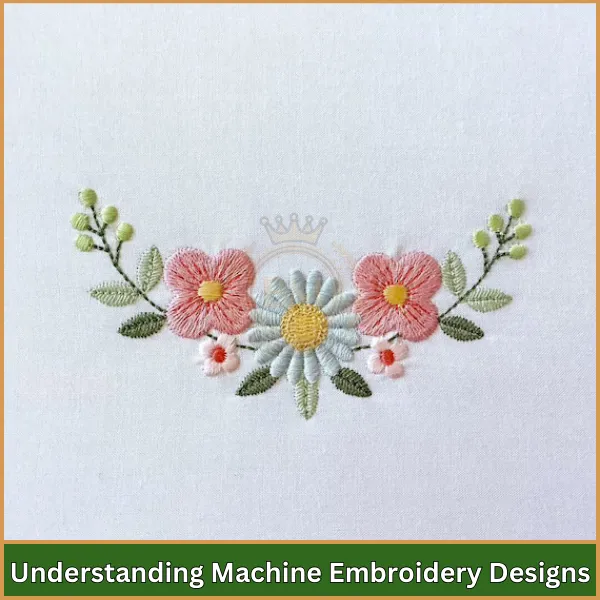
Sie sind digitale Muster, die die Stickmaschine beim Erstellen detaillierter Bilder leiten, Logos, und Text auf Stoff. Jedoch, Einfach ein Design zu haben ist nicht genug; Profi erreichen, Polierte Ergebnisse, Entwürfe müssen einen entscheidenden Schritt unterziehen, der als Digitalisierung bezeichnet wird.
Dieser Prozess wandelt das Design in ein maschinenlesbares Format um, mit präzisen Anweisungen, wie jeder Stich erstellt werden soll. If you’;Lern Sie nur die Maschine Stickereien Grundlagen, Wir empfehlen dringend, einen Fachmann zur Digitalisierung einzustellen, Da es Fachwissen erfordert, um Stichtypen anzupassen, Dichten, und Richtungen basierend auf Stoff- und Design -Feinheiten.
Für makellose Stickergebnisse, Die Einstellung eines professionellen Digitalisierers wird sehr empfohlen. Emdigitizing bietet außergewöhnliche D.Igitisierungsdienste Um Ihre Designs in hochwertige Stickdateien umzuwandeln. Unser Expertenteam bei Emdigitizing verwendet die neuesten Techniken, um sicherzustellen, dass jedes Design perfekt zu Ihrem Stoff und Ihrer Maschine geeignet ist, eine nahtlose Stickerfahrung liefern.
Durch Wahl EMdigitalisieren, Sie investieren in Präzision und Qualität, die Ihre Stickprojekte wirklich auszeichnet. Lassen Sie uns mit den Komplexität der Digitalisierung umgehen, damit Sie sich darauf konzentrieren können, schön zu kreieren, detaillierte Stickerei, die dauert. Bestellen Sie jetzt für ein professionelles Finish, dem Sie vertrauen können!
Dateiformate für Stickdesigns
Sie werden in bestimmten Dateiformaten gespeichert, die Stickmaschinen lesen und interpretieren können. Jede Maschinenmarke benötigt möglicherweise ein anderes Format, Es ist also wichtig zu wissen, welcher Dateityp zu Ihrer Ausrüstung passt.
- Sommerzeit: Ein weit verbreitetes Format, Besonders für kommerzielle Stickmaschinen.
- PES: Häufig mit Bruder- und Baby -Lock -Stickmaschinen verwendet.
- JEF: Verwendet von Janome -Maschinen und kompatibel mit verschiedenen Stickmaschinen zu Hause.
- EXP: Kompatibel mit Bernina-Maschinen und anderen professionellen Maschinen.
Das Auswählen des richtigen Dateiformat. Es stellt sicher, dass die Stichdetails und Spezifikationen Ihres Designs genau übertragen werden, was zu einem polierten Endprodukt führt.
Grundlegende Maschinenstickstiche verstehen
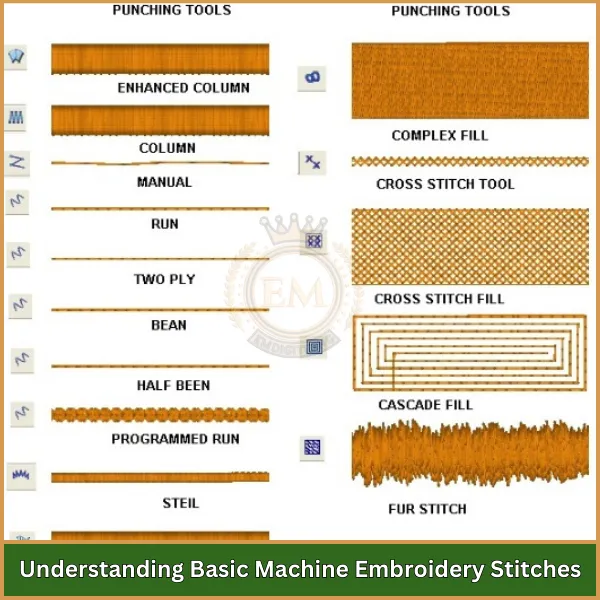
Beim Lernmaschinenstickerei -Grundlagen, Das Verständnis der verschiedenen Arten von Stichen ist für die Erstellung hochwertiger Designs von wesentlicher Bedeutung. Jeder Stichtyp fügt eine eindeutige Textur hinzu, Abmessungen, und Detail zu Ihren Stickprojekten. Hier ein Blick auf die häufigsten Stiche, die in der Maschinenstickerei verwendet werden:
- Plattstich: Bekannt für seine glatte, glänzendes Finish, Der Satinstich wird üblicherweise für Beschriftungen und Umrisse verwendet. Es schafft eine dichte, kühne Linie und ist ideal, um bestimmte Bereiche eines Designs zu betonen.
- Stich füllen (Tatami-Stich): Dieser Stich umfasst große Bereiche mit einer konsistenten Füllung und wird häufig für Hintergründe oder feste Formen verwendet. Das Stichmuster verhindert das Klopfen und vermittelt einen ausgewogenen, strukturiertes Aussehen.
- Vorstich: Eine einfache, Einzellinienstich, das zur Umsetzung verwendet wird, Details, Oder erstellen Sie feine Linien in einem Design. Es ist schnell und wirtschaftlich, Damit es für leichte Details geeignet ist.
- Bohnenstich (Dreifacher Stich): Ein verstärkter Laufstich, der jede Zeile dreimal übergeht, Erstellen eines mutigen, dauerhaftere Linie. Bohnenstiche eignen sich hervorragend zum Umriss und zum Hinzufügen einer Definition.
- Zickzackstich: Dieser Stich wechselt in einem Zick -Zack -Muster, Hinzufügen von Textur und einer etwas dehnbaren Qualität. Es ist nützlich, um Kanten zu sichern oder ein auffälliges Detail hinzuzufügen.
- Kettenstich: Nachahmung eines Hand-Sewn-Looks, Der Kettenstich wird häufig in dekorativen Stickereien verwendet. Es schafft eine strukturierte, Looped Effect, Fügen Sie dem Design Tiefe und Charakter hinzu.
- Kreuzstich: Wird verwendet, um ein Raster oder ein strukturiertes Muster zu erstellen, Kreuzstich ist oft in traditionelleren Designs zu sehen und fügt ein einzigartiges hinzu, altmodischer Charme.
- Französischer Knoten: Ein Spezialstich, der klein erzeugt, Erhöhte Knoten zum Hinzufügen von Details und Textur zu bestimmten Teilen des Designs, wie Blumenzentren oder Akzente.
Durch das Beherrschen dieser grundlegenden Maschinenstickstiche, Du kannst Schönes erschaffen, Vielseitige Designs mit einer Reihe von Texturen und Effekten, Erwecken Sie Ihre Projekte mit Stil und Präzision zum Leben.
Fazit
Abschließend, Mastering Machine Stickerei -Grundlagen setzen Sie auf den Weg zum Erstellen schöner, benutzerdefinierte Stücke mit Zuversicht. Egal, ob Sie gerade mit Ihren Fähigkeiten beginnen oder verfeinern, Gut vorbereitete Designs zu haben ist wichtig, um makellose Ergebnisse zu erzielen.
Zum Hochwertige Digitalisierungsdienstleistungen, Vertrauen Sie Emdigiting! Wir bieten die erschwinglichsten Preise an, superschnelle Bearbeitungszeiten, und eine Qualitätsgarantie für jedes Design. Plus, mit unserer Vorschau-Option, Sie können genau sehen, wie Ihr Design vor dem Nähen aussehen wird.
Und wenn es Ihr erstes Mal bei uns ist, Sie erhalten ein exklusives 50% aus. Bestellen Sie jetzt und lassen Sie Emdigitizing Ihre kreativen Ideen mit Präzision und Exzellenz zum Leben erwecken!
